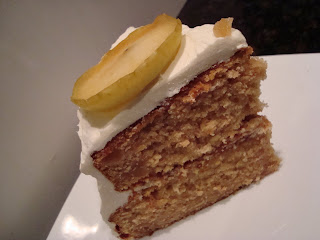 It's late September, which is the very end of peach season around here. I found myself with a wonderful abundance of late-summer peaches, and I wanted to use them in a dessert. I flipped through Martha's Baking Handbook, but she only had a few recipes which featured peaches. I was inspired by her recipe for Peach, Apricot, and Cherry Pie. I didn't have apricots or cherries on hand, but I know apricots are members of the peach family, so I thought it would be fine to substitute extra peaches for the apricots in the recipe. Several of Martha's recipes encourage bakers to substitute different berries for each other, so I decided to use raspberries (which I had in my freezer) instead of cherries.
It's late September, which is the very end of peach season around here. I found myself with a wonderful abundance of late-summer peaches, and I wanted to use them in a dessert. I flipped through Martha's Baking Handbook, but she only had a few recipes which featured peaches. I was inspired by her recipe for Peach, Apricot, and Cherry Pie. I didn't have apricots or cherries on hand, but I know apricots are members of the peach family, so I thought it would be fine to substitute extra peaches for the apricots in the recipe. Several of Martha's recipes encourage bakers to substitute different berries for each other, so I decided to use raspberries (which I had in my freezer) instead of cherries.If you're playing at home, here's a recipe for Peach-Raspberry Pie from Martha's web site.
I've never made peach pie before, but I thought it was interesting that this recipe called for unpeeled peaches. I'm used to peeling fruit before baking with it. But who am I to question Martha? If she wants sliced, unpeeled peaches, then that's what I'll use.

I defrosted my frozen raspberries and drained off most of their liquid, because I didn't want a soggy pie. I added the raspberries, as well as all of the other ingredients of the pie filling, to the peaches.

The filling still seemed very liquidy, but I wasn't sure if I should remove more of the liquid before adding the filling to the pie crust. I ended up draining about half of the liquid, but in retrospect, I probably should have removed even more. Martha's instructions were to keep the fruit juices in the filling, but I think the fact that I used frozen raspberries changed things.
Next, I added the filling to the bottom of the pie crust, and I dotted the top of the pie with small pieces of chilled butter.

See how much liquid was in there? Alarm bells were going off in my mind, but since I'd already filled the crust, I didn't think there was much I could do at that point.
Finally, I topped the pie with my lattice crust and sprinkled (raw) turbinado sugar over the top for some extra crunch and texture.

After an hour in the oven, I had a freshly baked pie!


As you can see, the crust could not fully contain the fruit juices, so they started to spill over the top. This wasn't a huge problem, except that it made the pie a little messy, and the bottom crust had less structure than I would have liked.
But the flavor... oh, the flavor of the pie was incredible! The peaches were ripe and full of flavor. The raspberries added just a hint of tartness. The crust was delicate, flaky, and oh-so-buttery. I had to control myself from eating half of the pie in one sitting. This one is definitely a keeper.

















 I love to bake, but I'm also inherently lazy. I often prefer to doctor cake mixes instead of baking from scratch. I received a copy of the Martha Stewart Baking Handbook as a gift, and I thought this would be a good opportunity to expand my baking repertoire.
I love to bake, but I'm also inherently lazy. I often prefer to doctor cake mixes instead of baking from scratch. I received a copy of the Martha Stewart Baking Handbook as a gift, and I thought this would be a good opportunity to expand my baking repertoire.


